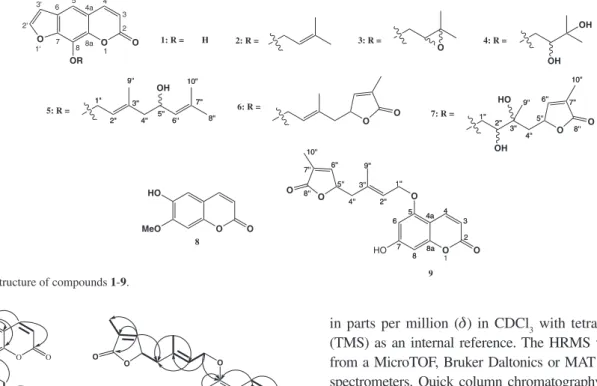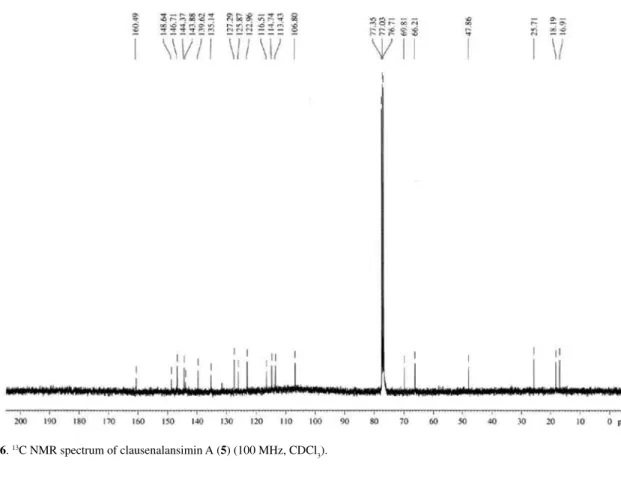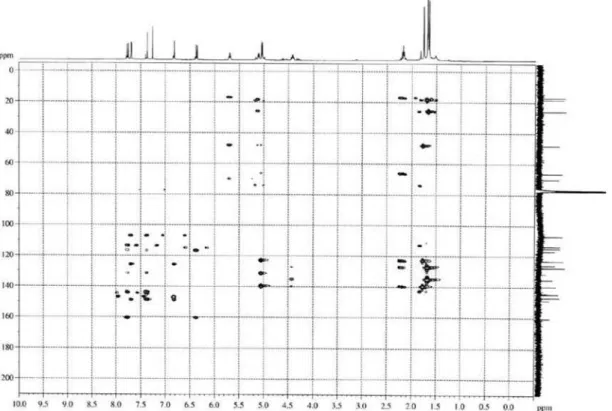Article
J. Braz. Chem. Soc., Vol. 21, No. 4, 665-668, 2010. Printed in Brazil - ©2010 Sociedade Brasileira de Química 0103 - 5053 $6.00+0.00
*e-mail: surat@mfu.ac.th; laphookhieo@yahoo.com
New Coumarins from
Clausena lansium
Twigs
Wisanu Maneerat,a Uma Prawat,b Nisakorn Saewanc and Surat Laphookhieo*,a
aNatural Products Research Laboratory, School of Science, Mae Fah Luang University, Tasud,
Muang, 57100 Chiang Rai, Thailand
bFaculty of Science and Technology, Phuket Rajabhat University, Muang, 83000 Phuket, Thailand
cSchool of Cosmetic Science, Mae Fah Luang University, Tasud, Muang,
57100 Chiang Rai, Thailand
Duas novas cumarinas, Clausenalansimin A (5) e B (9), juntamente com sete cumarinas conhecidas (1-4 e 6-8), foram isoladas de galhos de Clausena lansium. Todos os compostos foram determinados por métodos espectroscópicos. Alguns dos compostos isolados apresentaram citotoxicidade contra linhagens de células humanas cancerígenas (KB, MCF7 e NCI-H187).
Two new coumarins namely Clausenalansimin A (5) and B (9) together with seven known coumarins (1-4 and 6-8), were isolated from twigs of Clausena lansium. All compounds were determined by spectroscopic methods. Some of isolates had cytotoxicity against human cancer cell lines (KB, MCF7 and NCI-H187).
Keywords:Clausena lansium, coumarin, clausenalansimin A, clausenalansimin B, cytotoxicity
Introduction
Clausena lansium (Lour.) Skeels is a distant relative
of citrus fruit belonging to the Rutaceae family. Several parts of this plant have been used as a folk medicine in China and Taiwan. For example, the leaves have been used for the treatment of coughs, asthma and gastro-intestinal diseases, and the seeds for acute and chronic gastro-intestinal inlammation and ulcers.1 In addition, the fruits are used for inluenza, colds and abdominal colic pains in the Philippines.2 Recently, the seed extract of C. lansium was found to exhibit antifungal, antiproliferative, and HIV reverse transcriptase-inhibitory activities.3 Previous chemical investigations of this plant have revealed a number of alkaloids and coumarins.2,4-6 As parts of our continuing study on chemical constituents and biological activity of Thai medicinal plants, we report herein the isolation and structure elucidation of two new coumarins (5 and 9) along with seven known coumarins (1-4, 6-8) from the twigs of
C. lansium as well as the evaluation of cytotoxicity against
KB, MCF7 and NCI-H187 cancer cell lines. In addition, the 1H and 13C NMR spectral data of 7 are also reported herein for the irst time.
Results and Discussion
The combination of CH2Cl2 and acetone extracts of twigs of C. lansium was separated by chromatographic techniques to yield two new coumarins, clausenalansimin A (5) and B (9), together with seven known compounds (1-4,
6-8). All structures were elucidated using spectroscopic data and compared with those reported in the literature.
5-hydroxy-New Coumarins from Clausena lansium Twigs J. Braz. Chem. Soc. 666
3,7-dimethylocta-2,7-dienyloxy moiety. This moiety was also conirmed by COSY and HMBC correlations (Figure 2) and located at C-8 because the H-1′′ (d 5.04) showed 3J HMBC correlation with the carbon at C-8 (d 131.5). Therefore, clausenalansimin A was deduced to be 5.
Clausenalansimin B (9) was isolated as yellow viscous oil with a molecular formula of C19H18O6 on the basis of HREIMS. The 1H NMR spectral data of 9 revealed an
α,β-unsaturated lactone at d 6.12 (1H, d, J 9.6 Hz, H-3) and 7.96 (1H, d, J 9.6 Hz, H-4) and two meta-coupling aromatic protons at d 6.48 (1H, d, J 1.6 Hz, H-6) and 6.26 (1H, d, J 1.6 Hz, H-8).9 These results implied that this molecule is a 5,7-oxygenated coumarin nucleus. Moreover, the 1H NMR spectrum also showed signals of
−OCH2−CH=C− unit at d 4.66 (2H, m, H-1′′) and 5.53 (1H, t, J 5.6 Hz, H-2′′) and an α,β-unsaturated γ-lactone moiety at d 2.35 (1H, dd, J 17.0, 7.2 Hz, H-4a′′), 2.61 (1H, dd, J 17.0, 5.2 Hz, H-4b′′), 5.11 (1H, m, H-5′′), 7.09 (1H, br t, H-6′′), 1.92 (3H, br s, H-8′′).10 The side chain unit was also supported by COSY and HMBC experiments (Figure 2) and located at C−5 due to the 2J
and 3J HMBC correlations of the H-4 (d 7.96), H-6 (d 6.48) and H-1′′ (d 4.66) with C-5 (d 156.1). The structure of clausenalansimin B, therefore, was assigned to 9.
The remaining seven known coumarins included xanthotoxol (1),7 imperatorin (2),11 heraclenin (3),12 heraclenol (4),13 wampetin (6),14 indicolactonediol (7),15 and isoscopoletin (8)16 were determined by the 1D and 2D NMR spectral data and comparison with their reported physical and spectroscopic data. In addition, the complete assignments of 1H and 13C NMR of indicolactonediol (7) are also reported herein for the irst time (Table 1).
Only the stable compounds and suficient quantity were evaluated for their cytotoxicity against three human cancer cell lines including oral cavity cancer (KB), breast cancer (MCF7) and small cell lung cancer (NCI-H187). The results of cytotoxicity of the tested compounds (1-3,
5 and 6) are summarized in Table 2. All these compounds showed weak activity with cytotoxicity against KB, MCF7 and NCI-H187 cell lines, except coumarins 3 and
6 which were found to be inactive with MCF7 cancer cell line.
Table 1.1H and 13C NMR spectral data of 5, 7 and 9 in CDCl 3
Position 5 7 9
dH (J in Hz) dC dH (J in Hz) dC dH (J in Hz) dC
1 − − − − − −
2 − 160.4 − 160.4 − 162.1
3 6.36 (d, 9.6) 114.7 6.37 (d, 9.6) 114.8 6.12 (d, 9.6) 110.3
4 7.76 (d, 9.6) 144.3 7.78 (d, 9.6) 144.3 7.96 (d, 9.6) 139.2
4a − 116.5 − 116.5 − 103.8
5 7.36 (s) 113.4 7.42 (s) 114.0 − 156.1
6 − 125.8 − 126.0 6.48 (d, 1.6) 96.4
7 − 148.6 − 148.3 − 161.0
8 − 131.5 − 131.4 6.26 (d, 1.6) 96.9
8a − 143.8 − 143.5 − 156.6
2′ 7.68 (d, 2.0) 146.7 7.71 (d, 2.0) 146.8 − −
3′ 6.81 (d, 2.0) 106.8 6.84 (d, 2.0) 106.8 − −
1′′ 5.04 (d, 7.2) 69.8 4.56 (dd, 11.2, 5.6)
4.66 (dd , 11.2, 5.6)
72.0 4.66 (m) 66.0
2′′ 5.68 (dt, 7.2, 1.2) 122.9 3.52 (t, 5.6) 59.6 5.53 (t, 5.6) 125.1
3′′ − 139.6 − 73.9 − 133.4
4′′ 2.17 (m) 47.8 1.84 (dd, 14.8, 5.2)
2.11 (dd, 14.8, 8.4)
41.5 2.35 (dd, 17.0, 7.2) 2.61 (dd, 17.0, 5.2)
42.6
5′′ 4.41 (m) 66.2 4.92 (m) 72.0 5.11 (m) 79.6
6′′ 5.11 (m) 127.2 7.13 (t, 1.6) 148.5 7.09 (br t) 148.9
7′′ − 135.1 − 130.2 − 130.4
8′′ 1.68 (s) 16.9 1.92 (t, 1.6) 10.6 1.92 (br s) 10.6
9′′ 1.76 (s) 25.7 1.39 (s) 18.1 1.74 (s) 17.6
Maneerat et al. 667 Vol. 21, No. 4, 2010
Experimental
General procedures
The optical rotation [α]D values were determined with a Bellingham & Stanley ADP440 polarimeter. UV-Vis spectra were recorded with a Perkin-Elmer UV-Vis spectrophotometer. The IR spectra were recorded with a Perkin-Elmer FTS FT-IR spectrophotometer. The NMR spectra were recorded using 400 MHz Bruker spectrometer. Chemical shifts were recorded
in parts per million (d) in CDCl3 with tetramethylsilane (TMS) as an internal reference. The HRMS was obtained from a MicroTOF, Bruker Daltonics or MAT 95 XL mass spectrometers. Quick column chromatography (QCC) and column chromatography (CC) were carried out on silica gel 60 H (Merck, 5-40 μm) and silica gel 100 (Merck, 63-200 μm), respectively. Precoated plates of silica gel 60 F254 were used for analytical purposes.
Plant material
The twigs of C. lansium were collected in April 2008 from Nan Province, northern part of Thailand. Botanical identification was achieved through comparison with a voucher specimen number QBG 25077 in the herbarium collection of Queen Sirikit Garden, Mae Rim District, Chiang Mai, Thailand.
Extraction and Isolation
Air-dried twigs of C. lansium (6.73 Kg) were successively extracted with CH2Cl2 and acetone over a period of 3 days each at room temperature. The CH2Cl2 and acetone extracts were combined (34.02 g) and subjected to QCC over silica gel eluted with a gradient of hexane-acetone (100% hexane to 100% acetone) to provide seventeen fractions (A-Q). Fraction G (562.9 mg) upon standing at room temperature gave compound 2 (247.1 mg). Fraction I (1.83 g) was separated by CC using 20% EtOAc-hexane to give seven subfractions (I1-I7). Subfraction I7 (546.4 mg) was further puriied by CC with 30% hexane-CH2Cl2 yielding compound 3 (207.8 mg). Fraction K (4.64 g) was separated by CC eluted with a gradient of CH2Cl2-EtOAc (5% EtOAc-CH2Cl2 to 100% EtOAc) to give compound 1 (5.6 mg), and nine subfractions (K1-K9). Subfraction K6 (124.2 mg) was subjected to
Figure 1.Structure of compounds 1-9.
1" 1" 2" 2" 3'' 3'' 4'' 4'' 5'' 5'' 6'' 6'' 7'' 7'' 8'' 8'' 9'' 9'' OH 10'' 10'' = O O = O = OH OH O O HO MeO 8 O O O OR 1 3 4 5 6 7 8 4a 8a 2 1' 2' 3' 1'' 1'' 2'' 2'' 3'' 3'' 4'' 4'' 5'' 5''
O 8''8''
7'' 7'' 6'' 6'' 10'' 10'' O 9'' 9'' OH HO 6 6 7 7 8 8 8a 8a 4a 4a 5 5 O 2 2 3 3 4 4 O O HO 1'' 1'' 2'' 2'' 3'' 3'' 4'' 4'' 9'' 9'' 5'' 5'' 6'' 6'' 7'' 7'' 8'' 8'' O 10'' 10'' O 9 1
Table 2. Biological activity of furanocoumarins isolated from the stems of C. lansium
Compound Cytotoxicity (IC50, µg mL-1)
KBa MCF7b NCI−H187c
1 26.97 11.92 40.41
2 9.60 37.62 28.58
3 19.03 Inactive 17.40
5 22.09 31.02 28.83
6 17.93 Inactive 26.23
Doxorubicin 0.172 0.976 0.061
aKB = Oral cavity cancer; bMCF7 = Breast cancer; cNCI−H187 = Small cell lung cancer
Figure 2. COSY and selective HMBC Correlations of 5 and 9.
New Coumarins from Clausena lansium Twigs J. Braz. Chem. Soc. 668
repeated CC with 2% acetone-CH2Cl2 to afford compound 5
(8.7 mg). Puriication of fraction M (806.5 mg) was performed by sephadex LH20 with 60% CH2Cl2-MeOH, yielding ive subfractions (M1-M5). Subfraction M2 (199.9 mg) was further subjected to repeated CC with a gradient of CHCl3 -hexane (70% CHCl3-hexane to 100% CHCl3) to afford eleven subfractions (M2a-M2k). Subfraction M2b (49.9 mg) was further subjected to repeated CC with 80% CHCl3-hexane to yield four fractions (M2b1-M2b4). Compound 6 (4.8 mg) was derived from fraction M2b2 (18.5 mg) by repeated CC using 60% CHCl3-hexane whereas compound 7 (1.7 mg) was obtained from fraction M2b3 (21.5 mg) by repeated CC with 5% EtOAc-CHCl3. Subfraction M2d (8.6 mg) was further puriied by prep.TLC with 5% EtOAc-CHCl3 to afford 6 (7.3 mg). Fraction N (621.1 mg) was performed by CC with 40% EtOAc-hexane, yielding eleven subfractions (N1−N11). Subfraction N8 (65.5 mg) was separated by CC using a gradient of EtOAc-CH2Cl2 (10% EtOAc-CH2Cl2 to 25% EtOAc-CH2Cl2) to yield compound 9 (4.0 mg) while subfraction N10 (39.4 mg) was puriied by prep.TLC with 7% EtOAc-CH2Cl2 to give compound 4 (9.8 mg).
Clausenalansimin A (5)
Yellow viscous oil; [α]D27+48.1° (c 0.02, CHCl
3); UV λmax/nm (MeOH): 204, 216, 247, 299; IR (neat) νmax/cm-1: 3442, 2924, 2855, 1722, 1626, 1587, 1443, 1401, 1327, 1261, 1150, 1092, 1026, 870, 801, 754; 1H NMR (CDCl
3, 400 MHz) and
13C NMR (CDCl
3, 100 MHz), see Table 1; HRMS (APCI,
−ve) m/z: 389.1161 ([M+Cl ]-, calc. C
21H22O5Cl, 389.1156).
Clausenalansimin B (9)
Yellow viscous oil; [α]D27+17.24° (c 0.02, CHCl 3); UV
λmax/nm (MeOH): 207 and 329; IR (neat) νmax/cm-1: 2921, 1726, 1609, 1454, 1364, 1237, 1154, 1115, 823, 612; 1H NMR (CDCl3, 400 MHz) and 13C NMR (CDCl
3, 100 MHz): see Table 1; HREIMS m/z: 342.1158 ([M ]+, calc. C
19H18O6, 342.1103).
Cytotoxicity assay
The procedures for cytotoxic assay were performed by sulphorhodamine B (SRB) assay (anti-KB and MCF7) and colorimetric method (anti-NCI-H187) as described by Skehan
etal.6 In this study, three cancer cell lines, MCF7 (breast cancer), NCI-H187 (human, small cell lung cancer) and KB (oral human epidermal carcinoma) were used. Doxorubicin was the reference substance in this study.
Supplementary Information
Supplementary data are available free of charge at http://jbcs.sbq.org.br, as PDF ile.
Acknowledgments
We would like to thank the Thailand Research Fund (Grant no. RSA5280011) and Mae Fah Luang University for inancial support and to the Bioassay Research Facility of BIOTEC (Thailand) for cytotoxicity tests. WM thanks Mae Fah Luang University for a Ph.D graduate student research grant. We are indebted to Mr. Nitirat Chimnoi, Chulabhorn Research Institute, Bangkok, for recording mass spectrum and Ms. Nareerat Tongtip, Department of Chemistry, Faculty of Science, Phuket Rajabhat University for recording NMR spectral data. We also thank Assoc. Prof. Dr Chatchanok Karalai and Assoc. Prof. Chanita Ponglimanont, Department of Chemistry, Faculty of Science, Prince of Songkla University for supporting some scientiic material and giving valuable suggestions.
References
1. Adebajo, A. C.; Iwalewa, E. O.; Obuotor, E. M.; Ibikunle, G. F.; Omisore, N. O.; Adewunmi, C. O.; Obaparusi, O. O.; Klaes, M.; Adetogun, G. E.; Schmidt, T. J.; Verspohl, E. J.; J. Ethnopharmacol.
2009, 10, 122.
2. Lin, J. H.; Phytochemistry1989, 28, 621.
3. Ng, T. B.; Lam, S. K.; Fong, W. P.; Biol. Chem.2003, 384, 289. 4. Yang, M. H.; Chen, Y. Y.; Huang, L.; Phytochemistry 1988, 27, 445. 5. Kumar, V.; Vallipuram, K.; Adebajo, A. C.; Reisch, J.;
Phytochemistry1995, 40, 1563.
6. Skehan, P.; Storeng, R.; Scudiero, D.; Monks, A.; McMahon, J.; Vistica, D.; Warren, J. T.; Bokesch, H.; Kenney, S.; Boyd, R. M.; J. Natl. Cancer Inst. 1990, 82, 1107.
7. Ito, C.; Katsuno, S.; Furukawa, H.; Chem. Pharm. Bull.1998, 46, 341. 8. Gellért, M.; Reisch, J.; Szendrei, K.; Novák, I.; Csedö, K.;
Phytochemistry1972,11, 2894.
9. Ngadjui, B. T.; Ayafor, J. F.; Sondengam B. L.; Connolly, J. D.; Phytochemistry1989, 28, 585.
10. Nakamura, K.; Takemura, Y.; Ju-ichi, M.; Ito, C.; Furukawa, H.; Heterocycles1998, 43, 549.
11. Masuda, T.; Takasugi, M.; Anetai, M.; Phytochemistry1998, 47, 13. 12. Adityachaudhury, N.; Ghosh, D.; Choudhuri, A.; Phytochemistry
1974, 13, 235.
13. Razdan, T. K.; Kachroo, V.; Harkar, S.; Koul, S.; Phytochemistry
1982, 21, 923.
14. Khan, N. U.; Navqi, S. W. I.; Ishratullah, K.; Phytochemistry1983, 22, 2624.
15. Rakash, D.; Raj, K.; Kapil, R. S.; Popli, S. P.; Phytochemistry1978, 17, 1194.
16. Al-Barwani, F. M.; Eltayeb, E. A.; Biochem. Syst. Ecol.2004, 32, 1097.
Received: July 18, 2009
Supplementary Information
J. Braz. Chem. Soc., Vol. 21, No. 4, S1-S13, 2010. Printed in Brazil - ©2010 Sociedade Brasileira de Química 0103 - 5053 $6.00+0.00
*e-mail: surat@mfu.ac.th; laphookhieo@yahoo.com
New Coumarins from
Clausena lansium
Twigs
Wisanu Maneerat,a Uma Prawat,b Nisakorn Saewanc and Surat Laphookhieo*,a
aNatural Products Research Laboratory, School of Science, Mae Fah Luang University, Tasud,
Muang, 57100 Chiang Rai, Thailand
bFaculty of Science and Technology, Phuket Rajabhat University, Muang, 83000 Phuket, Thailand
cSchool of Cosmetic Science, Mae Fah Luang University, Tasud, Muang,
57100 Chiang Rai, Thailand
New Coumarins from Clausena lansium Twigs J. Braz. Chem. Soc. S2
Figure S2. 1H NMR spectrum of imperatorin (2) (400 MHz, CDCl 3).
Maneerat et al. S3 Vol. 21, No. 4, 2010
Figure S4. 1H NMR spectrum of heraclenol (4) (400 MHz, CDCl 3).
New Coumarins from Clausena lansium Twigs J. Braz. Chem. Soc. S4
Figure S6. 13C NMR spectrum of clausenalansimin A (5) (100 MHz, CDCl 3).
Maneerat et al. S5 Vol. 21, No. 4, 2010
Figure S8. COSY spectrum of clausenalansimin A (5) (400 MHz, CDCl3).
New Coumarins from Clausena lansium Twigs J. Braz. Chem. Soc. S6
Figure S10. HMBC spectrum of clausenalansimin A (5) (400 MHz, CDCl3).
Maneerat et al. S7 Vol. 21, No. 4, 2010
Figure S12. 1H NMR spectrum of indicolactonediol (7) (400 MHz, CDCl 3).
New Coumarins from Clausena lansium Twigs J. Braz. Chem. Soc. S8
Figure S14. DEPT 135° and 90°spectrum of indicolactonediol (7) (100 MHz, CDCl3).
Maneerat et al. S9 Vol. 21, No. 4, 2010
Figure S16. HMQC spectrum of indicolactonediol (7) (400 MHz, CDCl3).
New Coumarins from Clausena lansium Twigs J. Braz. Chem. Soc. S10
Figure S18. 1H NMR spectrum of indicolactonediol (8) (400 MHz, Acetone-d 6).
Maneerat et al. S11 Vol. 21, No. 4, 2010
Figure S20. 13C NMR spectrum of clausenalansimin B (9) (100 MHz, CDCl 3).
New Coumarins from Clausena lansium Twigs J. Braz. Chem. Soc. S12
Figure S22. COSY spectrum of clausenalansimin B (9) (400 MHz, CDCl3).
Maneerat et al. S13 Vol. 21, No. 4, 2010









